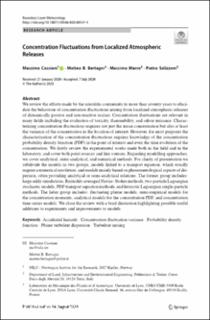| dc.description.abstract | We review the efforts made by the scientific community in more than seventy years to elucidate the behaviour of concentration fluctuations arising from localized atmospheric releases of dynamically passive and non-reactive scalars. Concentration fluctuations are relevant in many fields including the evaluation of toxicity, flammability, and odour nuisance. Characterizing concentration fluctuations requires not just the mean concentration but also at least the variance of the concentration in the location of interest. However, for most purposes the characterization of the concentration fluctuations requires knowledge of the concentration probability density function (PDF) in the point of interest and even the time evolution of the concentration. We firstly review the experimental works made both in the field and in the laboratory, and cover both point sources and line sources. Regarding modelling approaches, we cover analytical, semi-analytical, and numerical methods. For clarity of presentation we subdivide the models in two groups, models linked to a transport equation, which usually require a numerical resolution, and models mainly based on phenomenological aspects of dispersion, often providing analytical or semi-analytical relations. The former group includes: large-eddy simulations, Reynolds-averaged Navier–Stokes methods, two-particle Lagrangian stochastic models, PDF transport equation methods, and heuristic Lagrangian single-particle methods. The latter group includes: fluctuating plume models, semi-empirical models for the concentration moments, analytical models for the concentration PDF, and concentration time-series models. We close the review with a brief discussion highlighting possible useful additions to experiments and improvements to models. | en_US |

